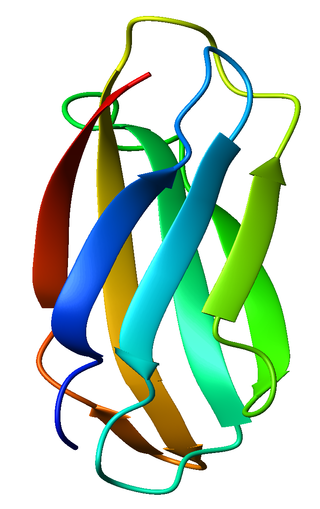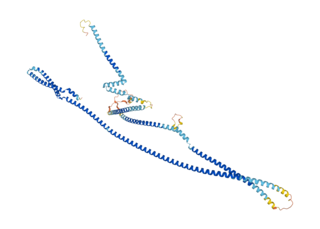Related Research Articles

Fibronectin is a high-molecular weight glycoprotein of the extracellular matrix that binds to membrane-spanning receptor proteins called integrins. It is approved for marketing as a topical solution in India by Central Drugs Standard Control organization in 2020 under the brand name FIBREGA for chronic wounds. Fibronectin also binds to other extracellular matrix proteins such as collagen, fibrin, and heparan sulfate proteoglycans.
Biological crosstalk refers to instances in which one or more components of one signal transduction pathway affects another. This can be achieved through a number of ways with the most common form being crosstalk between proteins of signaling cascades. In these signal transduction pathways, there are often shared components that can interact with either pathway. A more complex instance of crosstalk can be observed with transmembrane crosstalk between the extracellular matrix (ECM) and the cytoskeleton.

Versican is a large extracellular matrix proteoglycan that is present in a variety of human tissues. It is encoded by the VCAN gene.

Tenascins are extracellular matrix glycoproteins. They are abundant in the extracellular matrix of developing vertebrate embryos and they reappear around healing wounds and in the stroma of some tumors.
Teneurins are a family of phylogenetically conserved single-pass transmembrane glycoproteins expressed during pattern formation and morphogenesis. The name refers to "ten-a" and "neurons", the primary site of teneurin expression. Ten-m refers to tenascin-like protein major.

Syndecans are single transmembrane domain proteins that are thought to act as coreceptors, especially for G protein-coupled receptors. More specifically, these core proteins carry three to five heparan sulfate and chondroitin sulfate chains, i.e. they are proteoglycans, which allow for interaction with a large variety of ligands including fibroblast growth factors, vascular endothelial growth factor, transforming growth factor-beta, fibronectin and antithrombin-1. Interactions between fibronectin and some syndecans can be modulated by the extracellular matrix protein tenascin C.

A member of the tenascin family, tenascin X (TN-X) also known as flexillin or hexabrachion-like protein is a 450kDa glycoprotein that is expressed in connective tissues. TN-X possesses a modular structure composed, from the N- to the C-terminal part by a Tenascin assembly domain (TAD), a series of 18.5 repeats of epidermal growth factor (EGF)-like motif, a high number of Fibronectin type III (FNIII) module, and a fibrinogen (FBG)-like globular domain. In humans, tenascin X is encoded by the TNXB gene.

Matrilysin also known as matrix metalloproteinase-7 (MMP-7), pump-1 protease (PUMP-1), or uterine metalloproteinase is an enzyme in humans that is encoded by the MMP7 gene. The enzyme has also been known as matrin, putative metalloproteinase-1, matrix metalloproteinase pump 1, PUMP-1 proteinase, PUMP, metalloproteinase pump-1, putative metalloproteinase, MMP). Human MMP-7 has a molecular weight around 30 kDa.

Tenascin C (TN-C) is a glycoprotein that in humans is encoded by the TNC gene. It is expressed in the extracellular matrix of various tissues during development, disease or injury, and in restricted neurogenic areas of the central nervous system. Tenascin-C is the founding member of the tenascin protein family. In the embryo it is made by migrating cells like the neural crest; it is also abundant in developing tendons, bone and cartilage.

Cux1 is a homeodomain protein that in humans is encoded by the CUX1 gene.

Collagen alpha-1(XIV) chain is a protein that in humans is encoded by the COL14A1 gene. It likely plays a role in collagen binding and cell-cell adhesion.

Integrin alpha-9 is a protein that in humans is encoded by the ITGA9 gene. Cytogenetic location: 3p22.2

Integrin alpha-8 is a protein that in humans is encoded by the ITGA8 gene.

Laminin subunit gamma-3 also known as LAMC3 is a protein that in humans is encoded by the LAMC3 gene.

The Friedrich Miescher Institute for Biomedical Research (FMI) is a biomedical research institute founded in 1970. Based in Basel, Switzerland, the FMI is affiliated with the University of Basel and the Novartis Institutes for BioMedical Research (NIBR). It is named after Friedrich Miescher. As of 2021, the FMI has around 340 collaborators, of which 20 are research group leaders, over 80 are postdoctoral collaborators and over 80 are postgraduate students participating in the FMI International PhD Program. The FMI is directed by Dirk Schübeler.

Teneurin-3, also known as Ten-m3, Odz3, Ten-m/Odz3, Tenascin-like molecule major 3 or Teneurin transmembrane protein 3, is a protein that, in humans, is encoded by the TENM3, or ODZ3, gene. Ten-m3 is a ~300 kDa type II transmembrane glycoprotein that is a member of the teneurin/Ten-m/Odz family. The teneurin family currently consists of four members: Ten-m1-Ten-m4. Ten-ms are conserved across both vertebrate and invertebrate species. They are expressed in distinct, but often interconnected, areas of the developing nervous system and in some non-neural tissues. Like the Ten-m family, Ten-m3 plays a critical role in regulating connectivity of the nervous system, particularly in axon pathfinding and synaptic organisation in the motor and visual system. Mutation in the TENM3/ODZ3 gene in humans has been associated with the eye condition, microphthalmia.
Susan M. Gasser is a Swiss molecular biologist. From 2004 to 2019 she was the director of the Friedrich Miescher Institute for Biomedical Research in Basel, Switzerland, where she also led a research group from 2004 until 2021. She was in parallel professor of molecular biology at the University of Basel until April 2021. Since January 2021, Susan Gasser is director of the ISREC Foundation, which supports translational cancer research. She is also professor invité at the University of Lausanne in the department of fundamental microbiology. She is an expert in quantitative biology and studies epigenetic inheritance and genome stability. Recipient of multiple swiss and European awards, she was named member of the US Academy of Sciences in 2022.

Dirk Schübeler is a German researcher, Director of the Friedrich Miescher Institute for Biomedical Research (FMI) and professor at the University of Basel. He is an expert in gene regulation.

Nicolas H. Thomä is a German researcher, full professor at the EPFL School of Life Sciences and Director of the Paternot Chair for Cancer Research in Lausanne, Switzerland. He is a biochemist and structural biologist and a leading researcher in the fields of ubiquitin ligase biology and DNA repair.

Prisca Liberali is an Italian chemist who is a senior group leader at the Friedrich Miescher Institute for Biomedical Research. Her research takes a systems biology approach to understand the behaviour of multi-cellular systems. She was awarded the EMBO Gold Medal and EMBO Membership in 2022.
References
- ↑ "Ruth Chiquet-Ehrismann". FMI. Archived from the original on 25 April 2016. Retrieved 17 April 2016.
- ↑ FMI. "Obituary Ruth Chiquet-Ehrismann (1954 - 2015)". www.fmi.ch. Retrieved 2024-01-17.
- ↑ Matthias, Gabriele Yvonne. "The Gender Gap In Science Is Still Very Real". Forbes. Retrieved 17 April 2016.
- ↑ "Memorial: Ruth Chiquet-Ehrismann: Tenascin Pioneer" (PDF). The Matrix Letter. 14 (2): 7–8. Retrieved 17 April 2016.